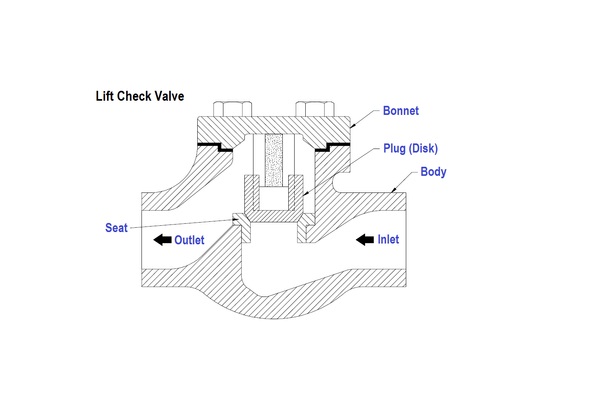Lift check valve refers to a valve that automatically opens and closes the valve flap by relying on the flow of the medium itself to prevent the backflow of the medium, also known as check valve, one-way valve, reverse flow valve, and back pressure valve. The check valve is an automatic valve whose main function is to prevent the backflow of the medium, the reverse rotation of the pump and the driving motor, and the discharge of the medium in the container. Check valves may also be used on lines supplying auxiliary systems where pressure may rise above system pressure. Check valves can be mainly divided into swing check valves (rotating according to the center of gravity) and lift check valves (moving along the axis).

Lift check valve installation method
1. The disc of the swing check valve is disc-shaped and rotates around the shaft of the valve seat channel. Because the inner channel of the valve is streamlined, the flow resistance is smaller than that of the butterfly check valve, which is suitable for low flow rate and flow. It is not suitable for pulsating flow in large-diameter occasions that do not change frequently, and its sealing performance is not as good as that of the lifting type. Butterfly check valve is divided into three types: single-lobe type, double-lobe type and multi-half type. These three forms are mainly divided according to the diameter of the valve.
2. Lifting check valve: a check valve whose disc slides along the vertical centerline of the valve body. The internal thread check valve can only be installed on a horizontal pipeline. On a high-pressure small-diameter check valve, a ball can be used for the disc. . The shape of the valve body of the butterfly check valve is the same as that of the globe valve (it can be used in common with the globe valve), so its fluid resistance coefficient is larger. Its structure is similar to the globe valve, and the valve body and disc are the same as the globe valve. The upper part of the valve disc and the lower part of the valve cover are machined with guide sleeves. The valve disc guide can be freely lifted and lowered in the valve guide. When the medium flows downstream, the valve disc is opened by the thrust of the medium. It falls vertically on the valve seat to prevent the reverse flow of the medium. The direction of the medium inlet and outlet channels of the straight-through butterfly check valve is perpendicular to the direction of the valve seat channel; the vertical lift check valve has the same direction of the medium inlet and outlet channels as the valve seat channel, and its flow resistance is smaller than that of the straight-through type.
3. Swing check valve: a check valve in which the disc rotates around the pin in the valve seat. The disc check valve has a simple structure and can only be installed on horizontal pipelines with good sealing performance.
4. Lift check valve: a valve in which the disc slides along the centerline of the valve body. Pipeline check valve is a new valve. It is small in size, light in weight and good in processing technology. It is one of the development directions of check valve. However, the fluid resistance coefficient is slightly larger than that of the swing check valve.
5. Compression check valve: This kind of valve is used as a valve for boiler feed water and steam cut-off. It has the comprehensive function of lift check valve and globe valve or angle valve. In addition, there are some check valves that are not suitable for pump outlet installation, such as bottom valve, lift check valve spring type, Y type and other check valves.
Lift check valve installation and maintenance
1. Both ends of the valve passage must be blocked, and there is a dry and ventilated room. In case of long-term storage, it should be checked frequently for corrosion prevention.
2. The valve should be cleaned before installation, and the defects caused during transportation should be eliminated.
3. During installation, it is necessary to carefully check whether the signs and nameplates on the valve meet the requirements for use.
4. The lift-type vertical flap check valve should be installed on the horizontal pipeline.
5. The lift-type horizontal flap check valve should be installed on the vertical pipeline.
6. Do not allow the check valve to bear weight in the pipeline. The large check valve should be supported independently so that it will not be affected by the pressure generated by the piping system.
7. When installing the check valve, special attention should be paid to the flow direction of the medium, and the normal flow direction of the medium should be consistent with the direction of the arrow indicated on the valve body, otherwise the normal flow of the medium will be cut off. The bottom valve should be installed at the bottom end of the suction line of the pump.
8. The general lift check valve should be installed on the horizontal pipeline, the vertical lift check valve and the bottom valve are generally installed on the vertical pipeline, and the medium flows from bottom to top.
9. When the check valve is closed, water hammer pressure will be generated in the pipeline, and in severe cases, it will cause damage to the valve, pipeline or equipment, especially for large-mouth pipelines or high-pressure pipelines, so it should cause the check valve selector. High attention.
 WENZHOU WEITUO VALVE CO., LTD.
WENZHOU WEITUO VALVE CO., LTD.